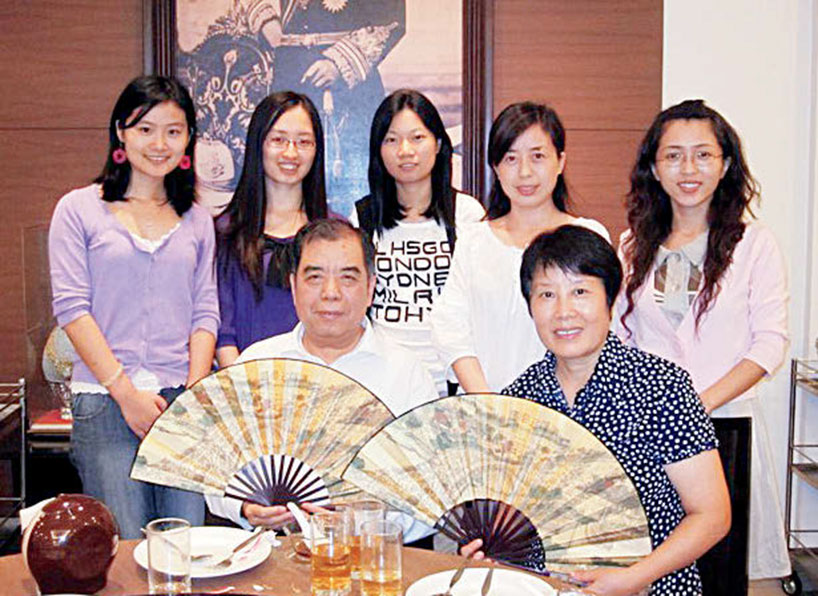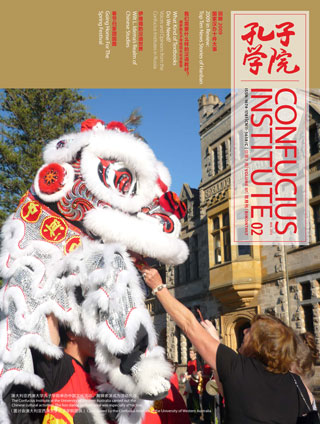

Wang Qin: “There is no ‘winter’ in Bangkok”
Wang Qin: “The students study very hard. Everyday my teaching class ends with laughter. Every time I teach a Chinese character, I also write on the blackboard both its oracle-bone inscription form and its original complex form, which helps students understand Chinese culture from the perspective of Chinese character forms, and make the learning of Chinese characters more lively, vivid and interesting”.
Currently there are over 4,000 Chinese language teachers and volunteers teaching Chinese in Confucius Institutes, primary and secondary schools and universities throughout the world. While spreading Chinese language and culture, these cultural envoys personally experienced exchanges and interactions with different teaching practices and other cultures. The column of Teachers’ Voices is a channel where Chinese language teachers and volunteers can share their teaching experience with each other. There will also be a collection of stories on their unique experiences in foreign lands these cultural envoys can share with our readers.
Wang Qin, Chinese teacher of the Confucius Institute at Chulalongkorn University, Thailand
It has become cool in Bangkok. The sun is not that hot and the breeze is quite pleasant. Everyday when I walk through the venerable and peaceful campus, and face students’ gentle and happy smiles, what I can feel is not the advent of winter but the enjoyment of the season.
I teach a class in elementary Chinese. The students are the civil servants of the Immigration Bureau of Thailand, who are very cute. The word “cute” may sound kind of inappropriate, but beginners learning a foreign language do resemble children in some ways. One day when I entered the lobby of the office building of Immigration Bureau, a female student greeted me politely, “Laoshi, zaijian (Teacher, goodbye)!” It turned out that she had confused “nihao (hello)” with “zaijian (goodbye)”. A man nearby corrected her, “Laoshi, nihao!” We all laughed. But I still praised the female student by saying, “You speak Chinese bravely. That’s great!” Another day, when I was in the classroom, a student came in. Standing in front of me, she looked at me with a smile, then looked up at the ceiling for a while, and then saluted me and said very seriously, “Laoshi, nihao!” It was not until then that I understood: the reason why she was so uneasy at first; it was that she had been thinking about how to greet me in Chinese.

The students study very hard. Everyday my teaching class ends with laughter. Every time I teach a Chinese character, I also write on the blackboard both its oracle-bone inscription form and its original complex form, which helps students understand Chinese culture from the perspective of Chinese character forms, and make the learning of Chinese characters more lively, vivid and interesting. For example, when explaining the Chinese character “ 取 (qu, to get)”, I told my students that in ancient wars in China, “to get the enemy’s left ear with one’s right hand” is a token of killing a prisoner and making a military achievement. (Note: The character 取 consists of two parts. The left part 耳 means ear in English, and the right part 又 has the same pronunciation (you) as another character 右 meaning the right. ) Once in class, when I was explaining two Chinese characters “ 女(nu, female)” and “ 马 (ma, horse)”, I incidentally mentioned another character “ 妈 (ma, mother)”. A student at once asked, “Does ‘ 妈’ mean ‘female horse’?” It made me laugh and at the same time I marveled at the students’ associative ability and was deeply moved by their hard working attitude.
Students are capable of recognizing and reading Chinese characters. It is not difficult for them to read the Chinese character being taught according to pinyin. But writing Chinese characters is comparatively difficult. When they copy the strokes of a Chinese character, they just don’t know how to start writing. Therefore, for each character I teach, I write it down on the blackboard four or five times. During the whole process, I write it very slowly one stroke after another, and have them watch while I write. The way some students write characters is like drawing a picture. For example, “ 口 (kou, mouth)” is written with one stroke, with two lines outside of the character “ 口”. On the contrary, some students write very seriously and in the standard way. They always show me the characters they wrote. When they get my praise, they are very happy and appreciate their work.
After two months’ study, the students have learned some words and sentences, and can have simple daily conversations. In one class I was teaching the usage of “ 好 (hao, good)” by giving students examples like “ 身体好 (shenti hao, good health)”and “学习好 (xuexi hao, good academic performance)”. When a student added, “ 今天很好。(Jin tian hen hao; Today is very good.)” I asked him why. He said, “Because today Laoshi forgot to ask us to write from memory. When I think of writing from memory, I get very nervous.”
In Thailand, my happiest moments are being with my students. Some students told me, “Laoshi, you don’t need to fear anything in Thailand as long as you declare that you are the teacher of police officers of the Immigration Bureau of Thailand.” I can feel they are very proud of themselves, and at the same time I am also very gratified.
When I am in Bangkok, everyday is sunny. My mood is just like the weather here: having no cloudy days. Now, the most pleasing season has begun in Bangkok, and my work has also reached its best. There is no winter in Bangkok and I believe my life in Bangkok will never be confronted with chilliness.























No hay comentarios:
Publicar un comentario